Evaluation Method on Energy-Efficient Retrofitting of Wooden Walls of Chinese Traditional Dwelling—A Case Study of Rendetang in Jinhua
Abstract
:1. Introduction
2. Materials and Methods
2.1. Experimental Materials
2.2. Method
2.2.1. Technical Route
2.2.2. Field Measurement and Investigation
2.2.3. Numerical Simulation
2.2.4. Two-Level Index Evaluation Method
- (1)
- First-level index evaluation
- (2)
- Second-level index evaluation
3. Case Study
3.1. Introduction of Traditional Dwelling Retrofitting Case
3.2. Retrofitting Measures
3.3. Simulation Process
3.4. Simulation Results
4. Evaluation and Discussion
4.1. First-Level Index Evaluation (Energy-Saving Effect)
4.2. Second-Level Index Evaluation (Economic Efficiency)
4.3. Relationship between Wall Thickness and Energy-Efficient Retrofitting
4.4. Limitations and Further Research
5. Conclusions
Author Contributions
Funding
Institutional Review Board Statement
Informed Consent Statement
Data Availability Statement
Conflicts of Interest
Nomenclature
| HTC | Heat transfer coefficient |
| XPS | Extruded polystyrene board |
| SIPs | Structural insulated panels |
| TMY | Typical meteorological year |
| NPV | Net Present Value |
| r | Discount rate |
| Ct | Cash flow in year t |
| CO | Initial incremental investment cost |
| ΔPt | The dynamic investment payback period |
| AN − 1 | The cumulative net cash flows with the last negative item |
| CN | the cumulative net cash flow of year N |
References
- IEA. Key world energy statistics. Int. Energy Agency 2014, 2011, 3. [Google Scholar]
- 2019 Global Status Report for Buildings and Construction. Available online: https://www.iea.org/reports/global-status-report-for-buildings-and-construction-2019 (accessed on 15 June 2022).
- Building Energy Efficiency Research Center of Tsinghua University. 2020 Annual Report on China Building Energy Efficiency; China Architecture & Building Press: Beijing, China, 2020. [Google Scholar]
- Martínez-Molina, A.; Tort-Ausina, I.; Cho, S.; Vivancos, J.-L. Energy efficiency and thermal comfort in historic buildings: A review. Renew. Sustain. Energy Rev. 2016, 61, 70–85. [Google Scholar] [CrossRef]
- Galatioto, A.; Ciulla, G.; Ricciu, R. An overview of energy retrofit actions feasibility on Italian historical buildings. Energy 2017, 137, 991–1000. [Google Scholar] [CrossRef]
- Ascione, F.; De Rossi, F.; Vanoli, G.P. Energy retrofit of historical buildings: Theoretical and experimental investigations for the modelling of reliable performance scenarios. Energy Build. 2011, 43, 1925–1936. [Google Scholar] [CrossRef]
- Ascione, F.; Bianco, N.; De Masi, R.F.; de’Rossi, F.; Vanoli, G.P. Energy retrofit of an educational building in the ancient center of Benevento. Feasibility study of energy savings and respect of the historical value. Energy Build. 2015, 95, 172–183. [Google Scholar] [CrossRef]
- Sugár, V.; Talamon, A.; Horkai, A.; Kita, M. Energy saving retrofit in a heritage district: The case of the Budapest. J. Build. Eng. 2020, 27, 100982. [Google Scholar] [CrossRef]
- Ge, J.; Lu, J.; Wu, J.; Luo, X.; Shen, F. Suitable and energy-saving retrofit technology research in traditional wooden houses in Jiangnan, South China. J. Build. Eng. 2022, 45, 103550. [Google Scholar] [CrossRef]
- Shen, Y.; Yan, X.; Yu, P.; Liu, H.; Wu, G.; He, W. Seismic resistance of timber frames with mud and stone infill walls in a Chinese traditional village dwelling. Buildings 2021, 11, 580. [Google Scholar] [CrossRef]
- Yuan, C.; He, Y.; Feng, Y.; Wang, P. Fire hazards in heritage villages: A case study on Dangjia Village in China. Int. J. Disaster Risk Reduct. 2018, 28, 748–757. [Google Scholar] [CrossRef]
- Song, L.; Lin, B.; Zhu, Y. Simulation of the summer indoor thermal condition of a traditional Chinese residential building in Anhui. Qinghua Daxue Xuebao/J. Tsinghua Univ. (China) 2003, 43, 826–828. [Google Scholar]
- Ma, Z.; Cooper, P.; Daly, D.; Ledo, L. Existing building retrofits: Methodology and state-of-the-art. Energy Build. 2012, 55, 889–902. [Google Scholar] [CrossRef]
- Chen, X.; Yang, H.; Lu, L. A comprehensive review on passive design approaches in green building rating tools. Renew. Sustain. Energy Rev. 2015, 50, 1425–1436. [Google Scholar] [CrossRef]
- Han, J.; Yang, X. Analysis of passive energy-saving retrofitting of rural residential houses in southern Anhui Province-A case in Hongcun. Energy Procedia 2018, 152, 470–474. [Google Scholar] [CrossRef]
- Litti, G.; Audenaert, A.; Lavagna, M. Life cycle operating energy saving from windows retrofitting in heritage buildings accounting for technical performance decay. J. Build. Eng. 2018, 17, 135–153. [Google Scholar] [CrossRef]
- Jelle, B.P. Traditional, state-of-the-art and future thermal building insulation materials and solutions–Properties, requirements and possibilities. Energy Build. 2011, 43, 2549–2563. [Google Scholar] [CrossRef] [Green Version]
- Li, Z.; Yang, H.; Chen, Y. The improvement of thermal insulation performance of traditional houses of Miao nationality in western Hu’nan province. Huazhong Archit. 2021, 39, 30–34. [Google Scholar]
- Liu, S.H. Chunhua, Analysis of the thermal environment and energy-saving retrofitting of a traditional dwelling in western Hunan. Build. Sci. 2016, 32, 27–32. [Google Scholar]
- Code for Thermal Design of Civil Building. In State Administration for Market Regulation of China: Beijing, China, 2016; Vol. GB 50176-2016. Available online: https://www.chinesestandard.net/PDF/English.aspx/GB50176-2016 (accessed on 15 June 2022).
- Xu, H.; Li, S.; Wu, J. Natural expression of modern wood buildings in Nordic Region. Urban. Archit. 2013, 15, 42–45. [Google Scholar]
- Li, Q.; Peng, K.; Wang, X.; Yang, J.; Bin, T. Renovation of Chinese ethnic structural wooden buildings in Qiandongnan Miao and Dong autonomous prefectures in Guizhou province. Chin. J. Wood Sci. Technol. 2018, 32, 38–41. [Google Scholar]
- Bianco, L.; Serra, V.; Fantucci, S.; Dutto, M.; Massolino, M. Thermal insulating plaster as a solution for refurbishing historic building envelopes: First experimental results. Energy Build. 2015, 95, 86–91. [Google Scholar] [CrossRef]
- Martín-Garín, A.; Millán-García, J.A.; Terés-Zubiaga, J.; Oregi, X.; Rodríguez-Vidal, I.; Baïri, A. Improving energy performance of historic buildings through hygrothermal assessment of the envelope. Buildings 2021, 11, 410. [Google Scholar] [CrossRef]
- Qu, K.; Chen, X.; Wang, Y.; Calautit, J.; Riffat, S.; Cui, X. Comprehensive energy, economic and thermal comfort assessments for the passive energy retrofit of historical buildings-A case study of a late nineteenth-century Victorian house renovation in the UK. Energy 2021, 220, 119646. [Google Scholar] [CrossRef]
- Cai, S.; Zhang, B.; Cremaschi, L. Review of moisture behavior and thermal performance of polystyrene insulation in building applications. Build. Environ. 2017, 123, 50–65. [Google Scholar] [CrossRef]
- Ozarisoy, B.; Altan, H. Developing an evidence-based energy-policy framework to assess robust energy-performance evaluation and certification schemes in the South-eastern Mediterranean countries. Energy Sustain. Dev. 2021, 64, 65–102. [Google Scholar] [CrossRef]
- Eltaweel, A.; Su, Y. Controlling venetian blinds based on parametric design; via implementing Grasshopper’s plugins: A case study of an office building in Cairo. Energy Build. 2017, 139, 31–43. [Google Scholar] [CrossRef] [Green Version]
- Fu, C.; Mak, C.M.; Fang, Z.; Oladokun, M.O.; Zhang, Y.; Tang, T. Thermal comfort study in prefab construction site office in subtropical China. Energy Build. 2020, 217, 109958. [Google Scholar] [CrossRef]
- Zhu, L.; Wang, Z.; Sun, Y.; Shao, Z. Economic evaluation of energy saving technology for building envelope: Taking a residential building in Henan as an example. Build. Energy Effic. 2017, 45, 123–126. [Google Scholar]
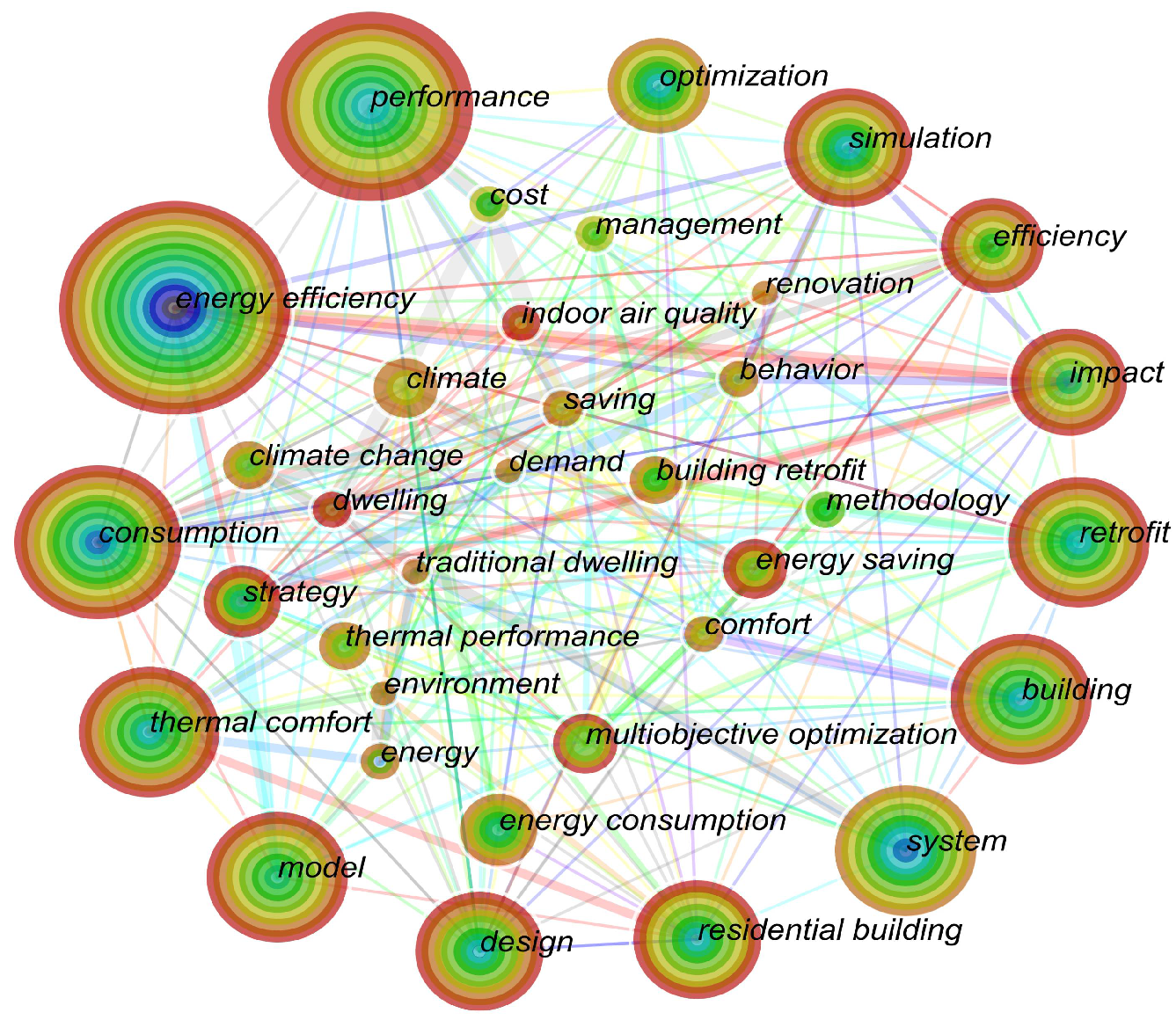
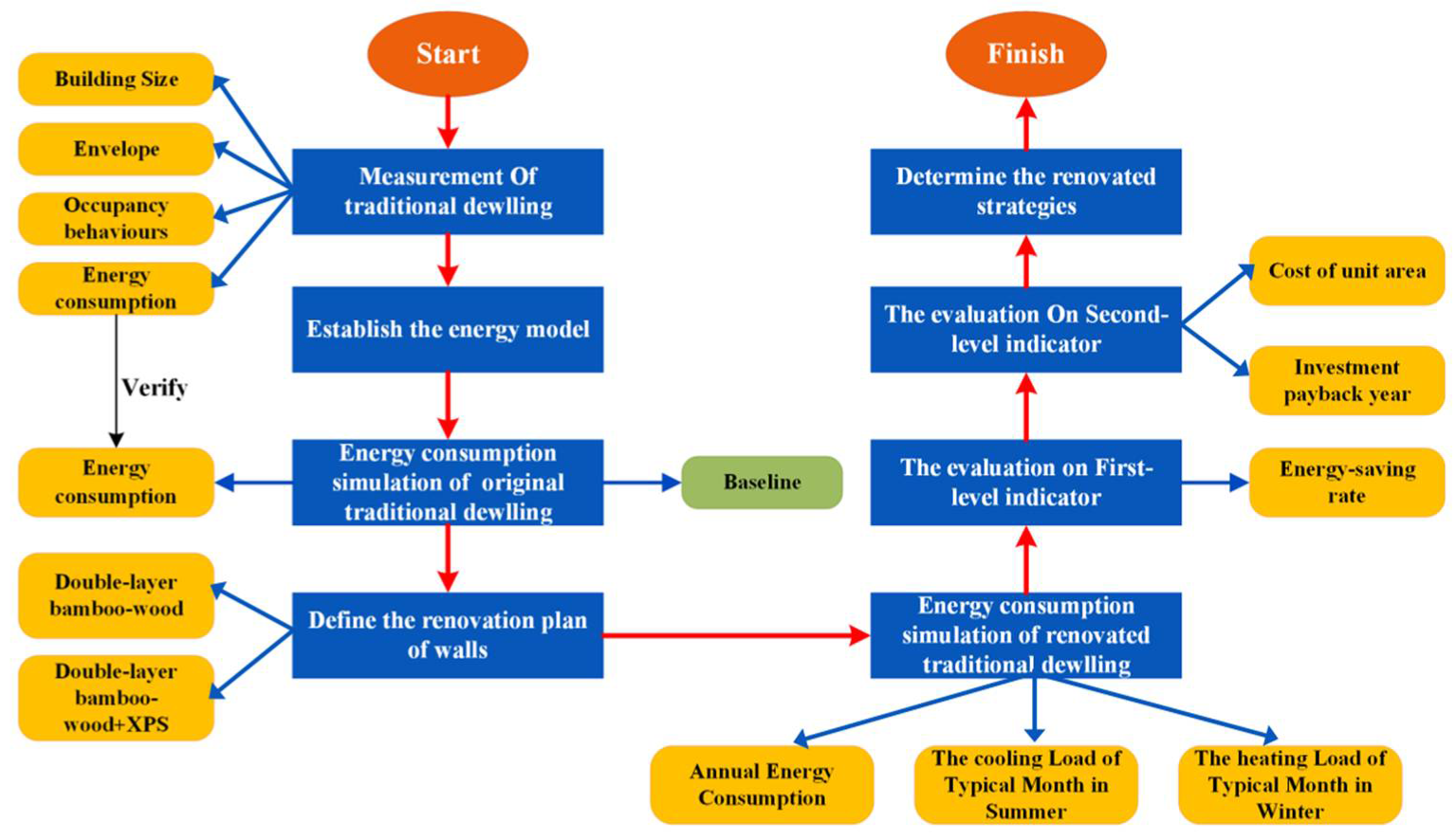
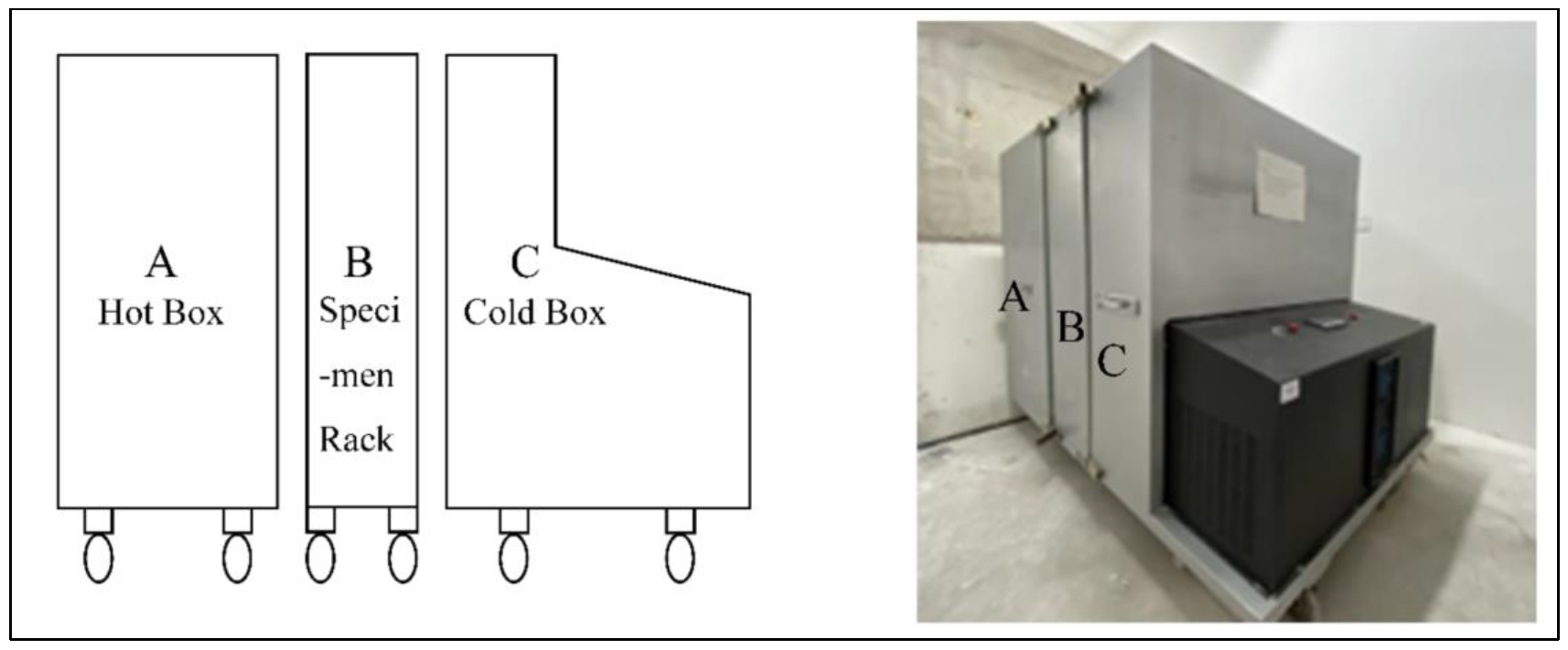

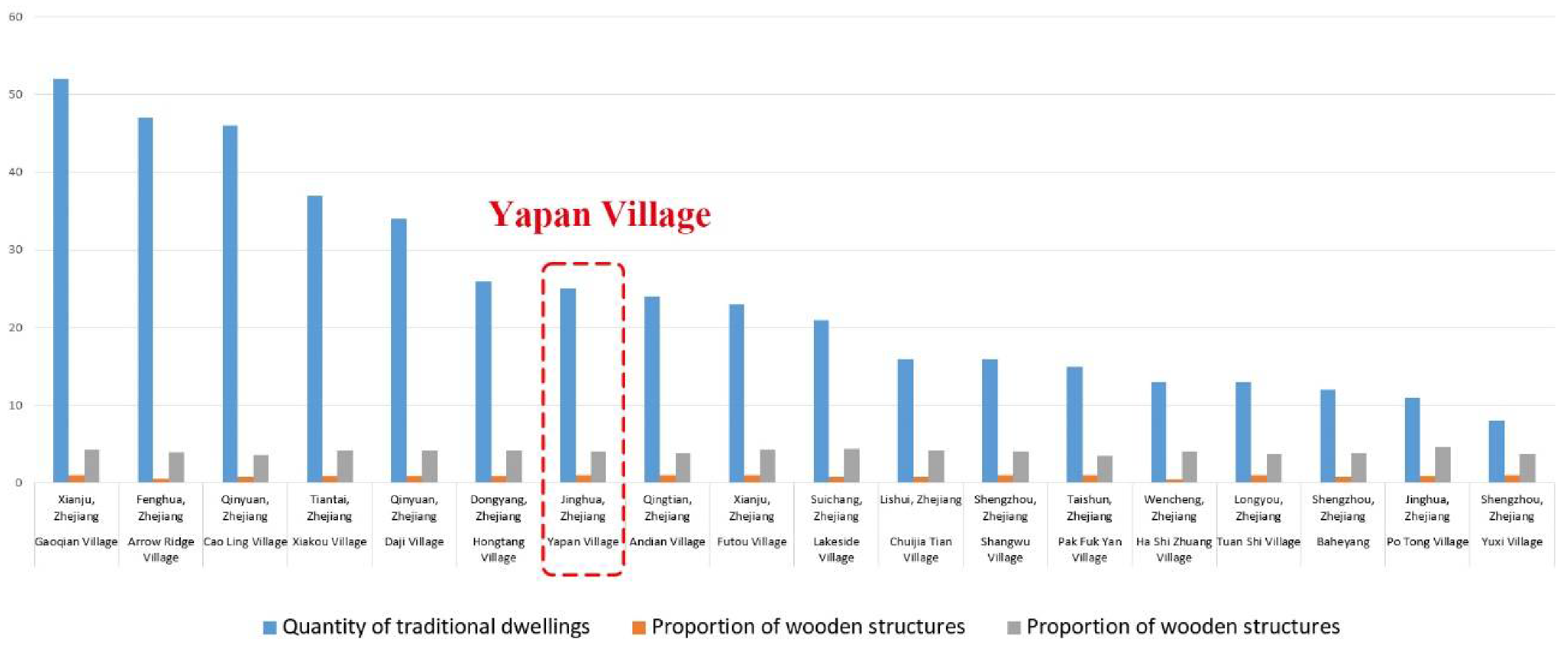
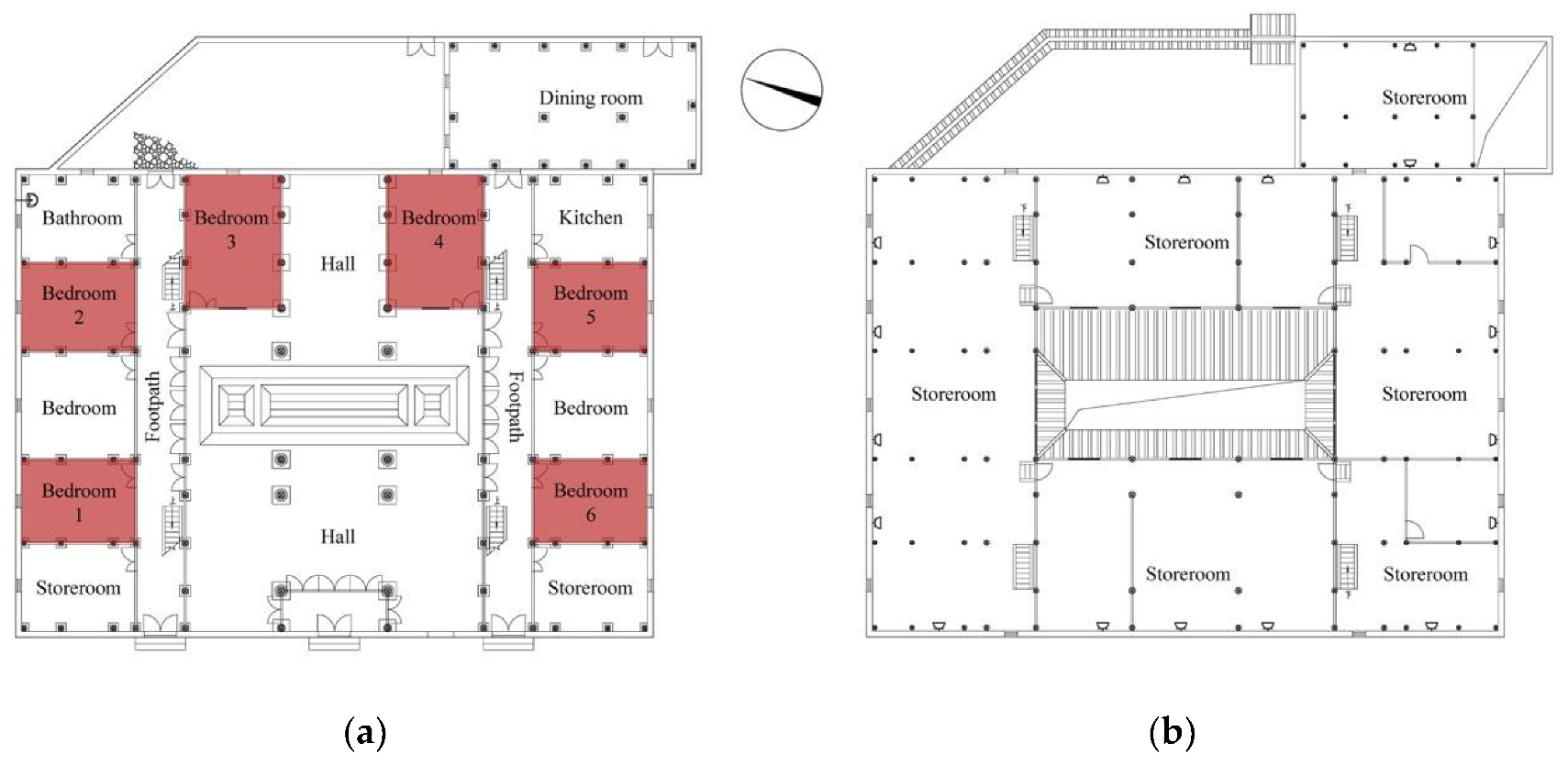
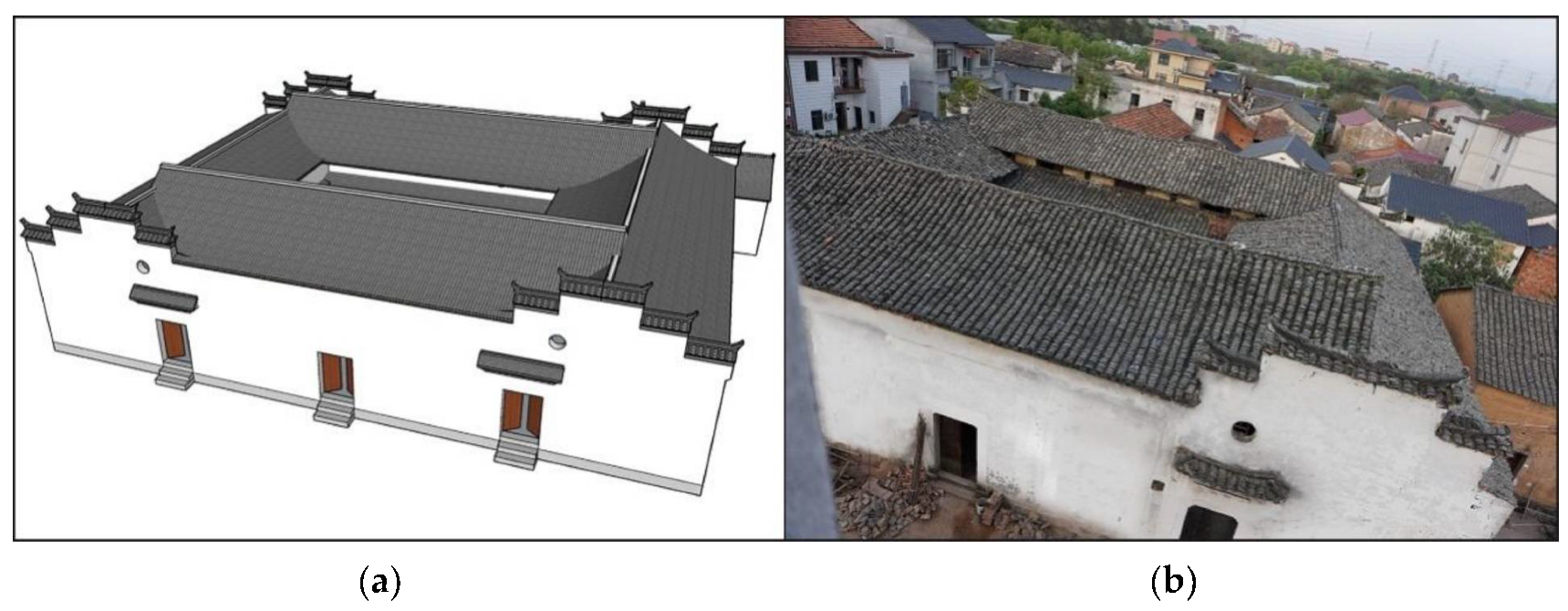
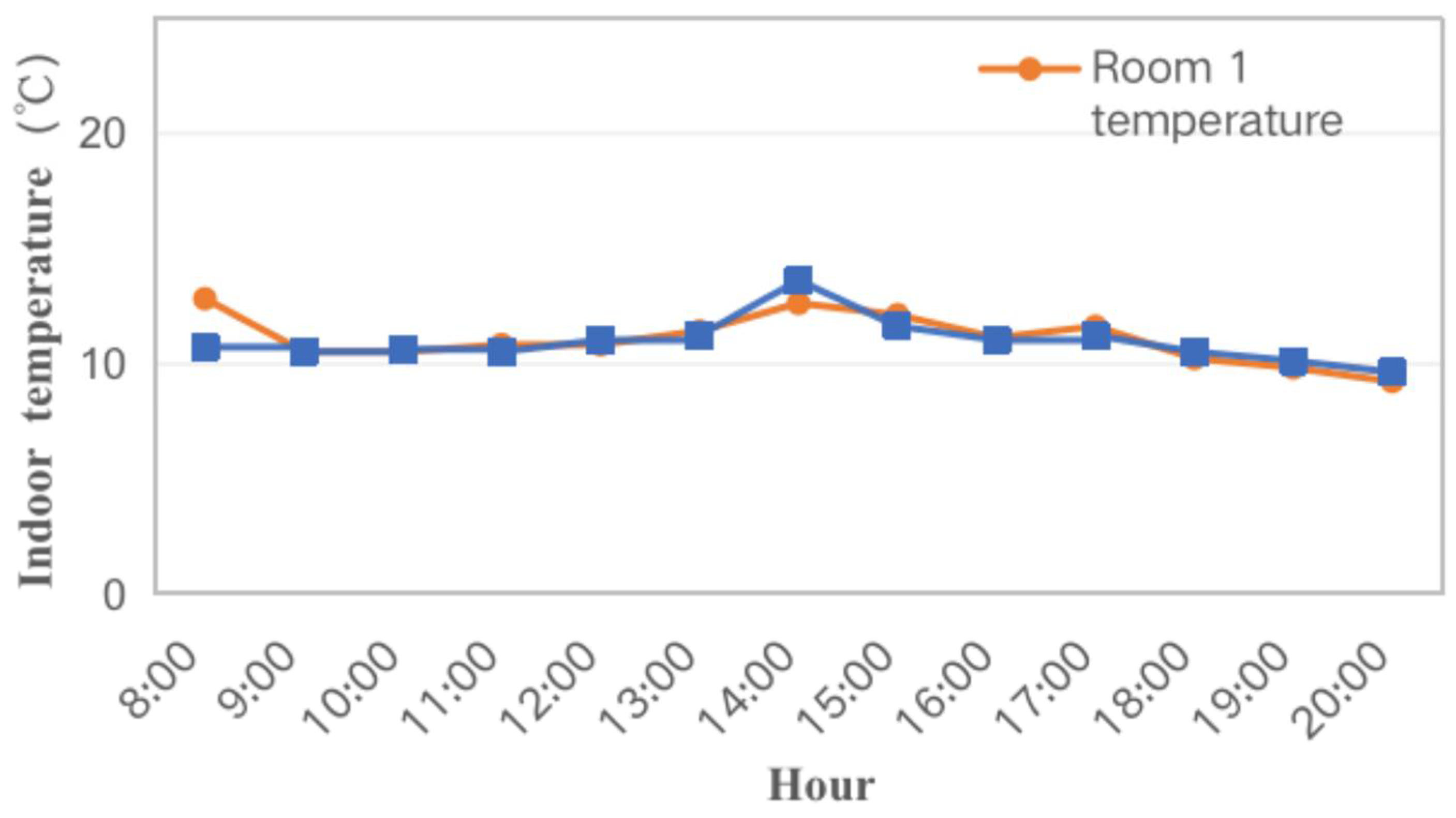
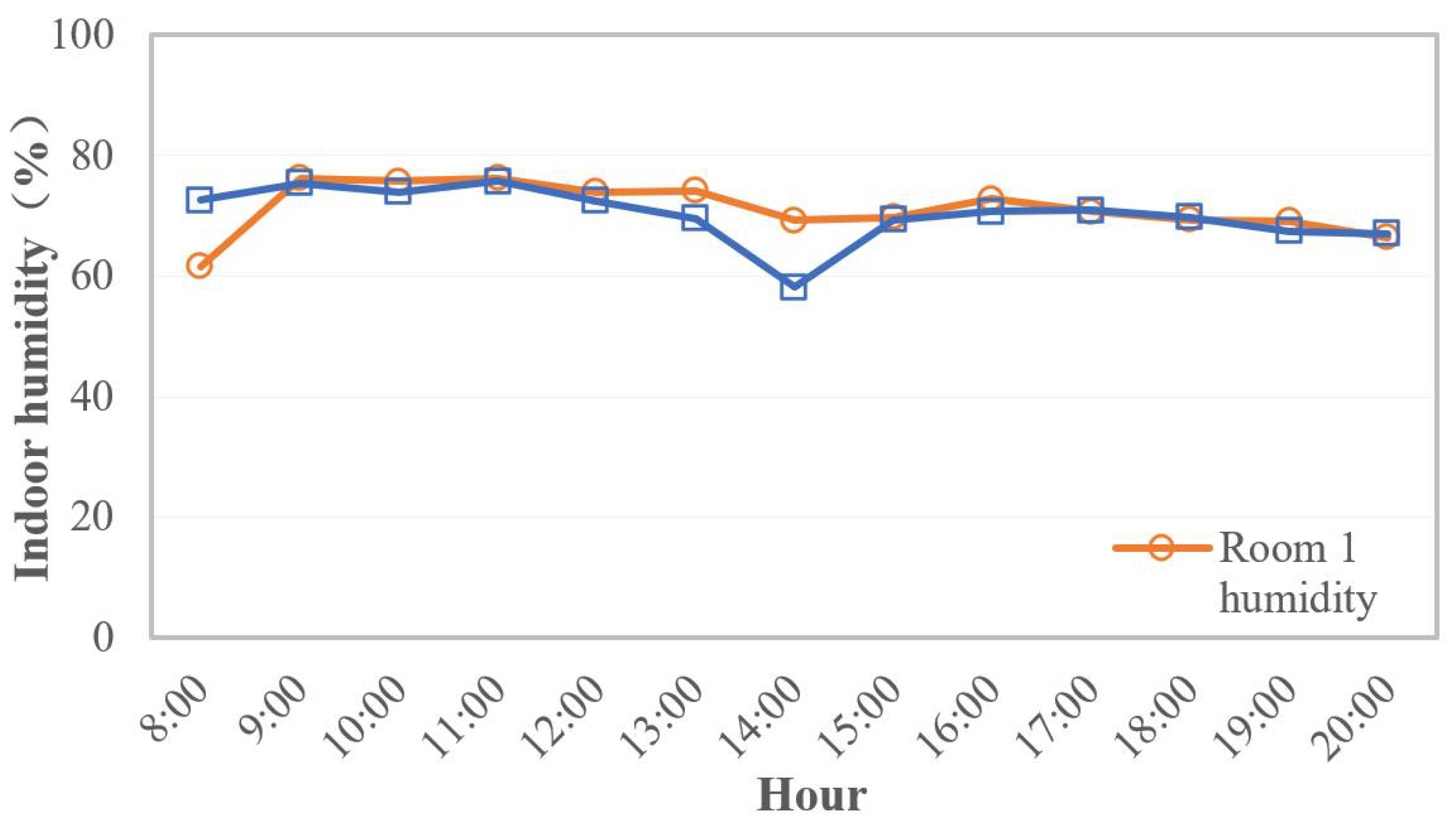
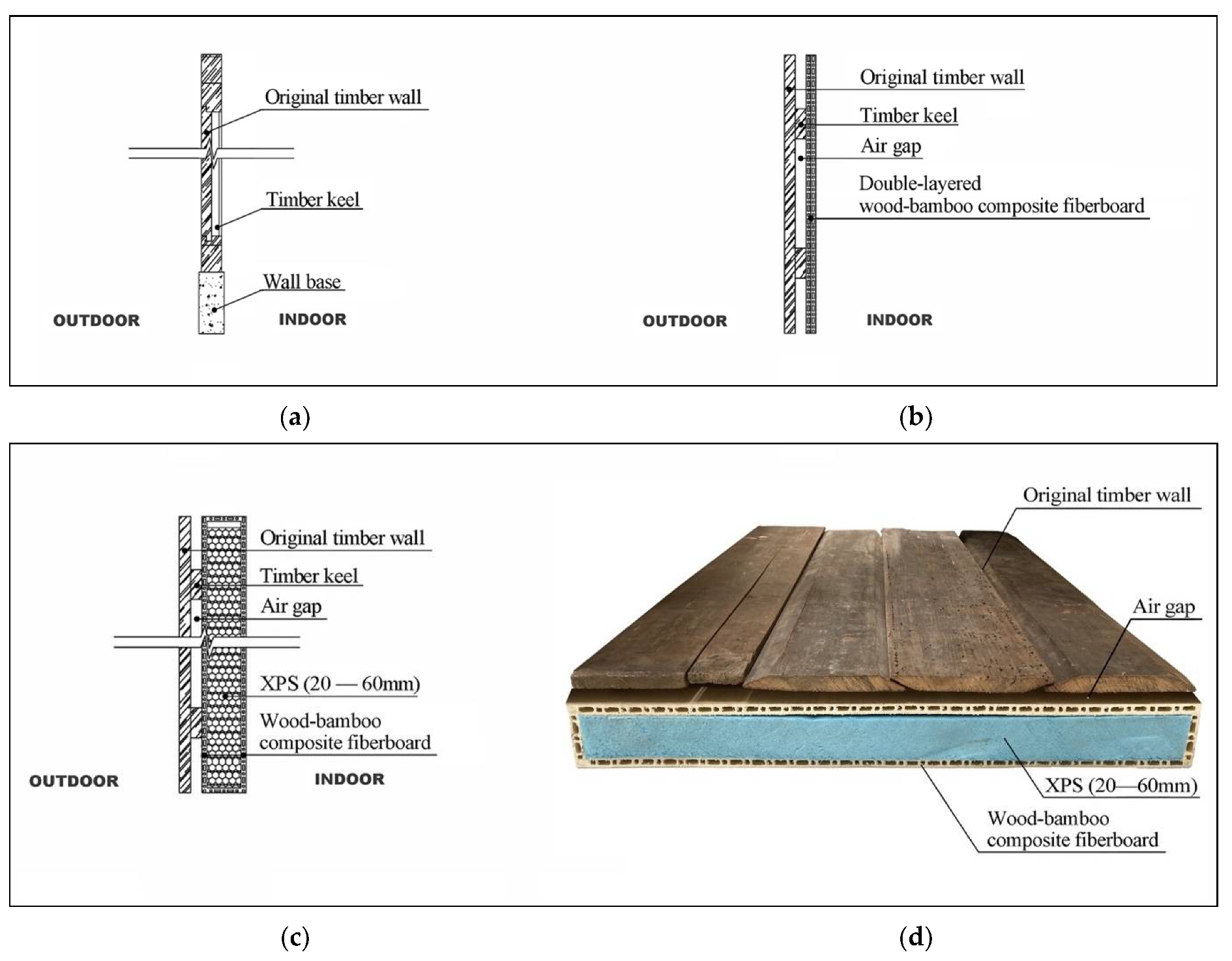
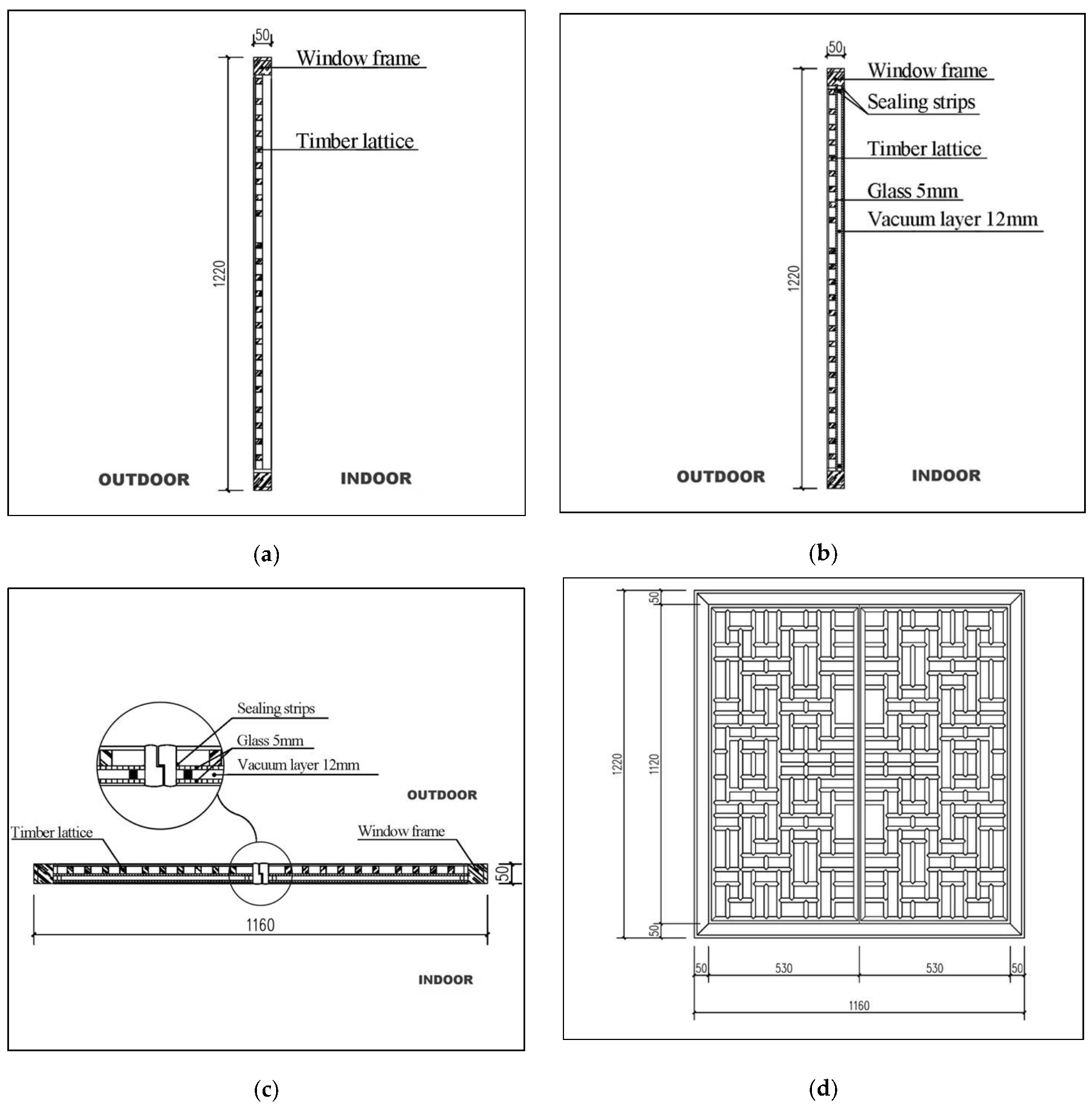
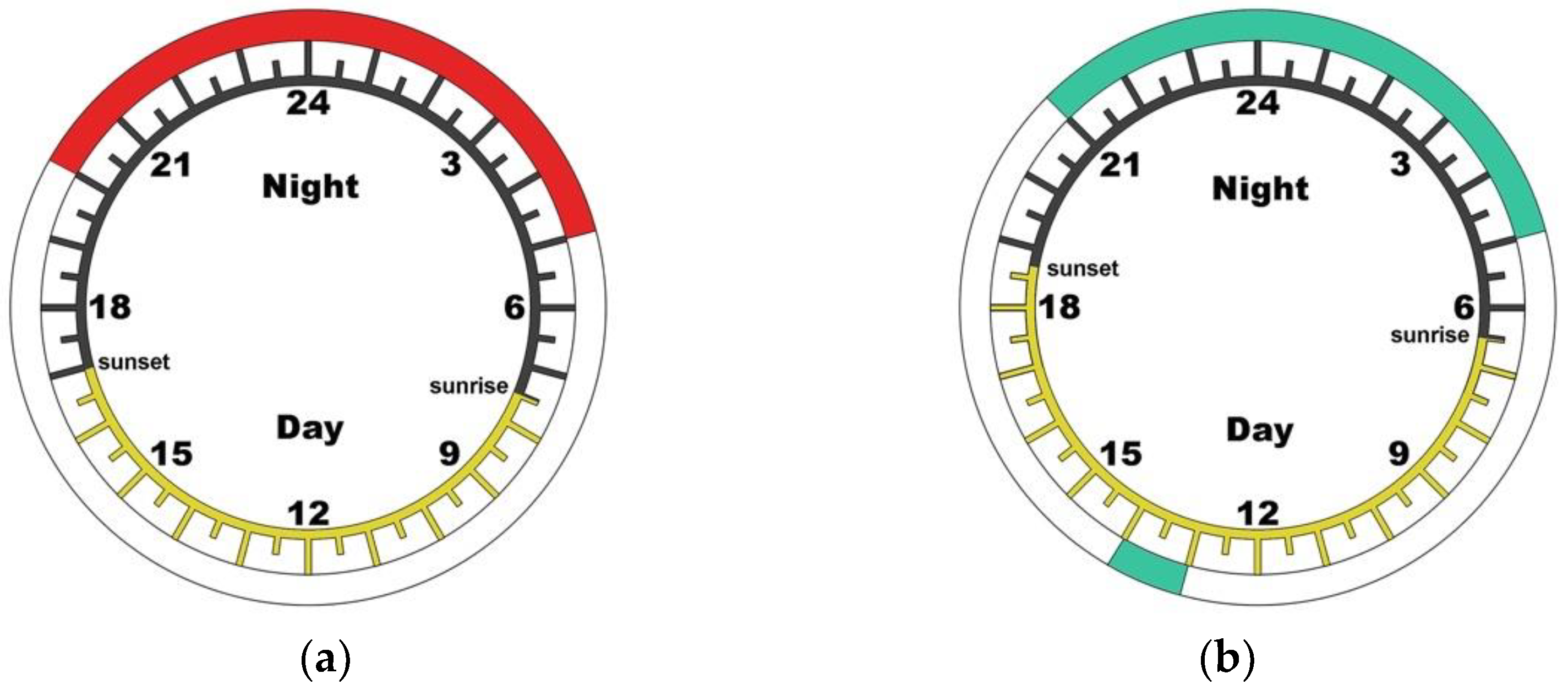
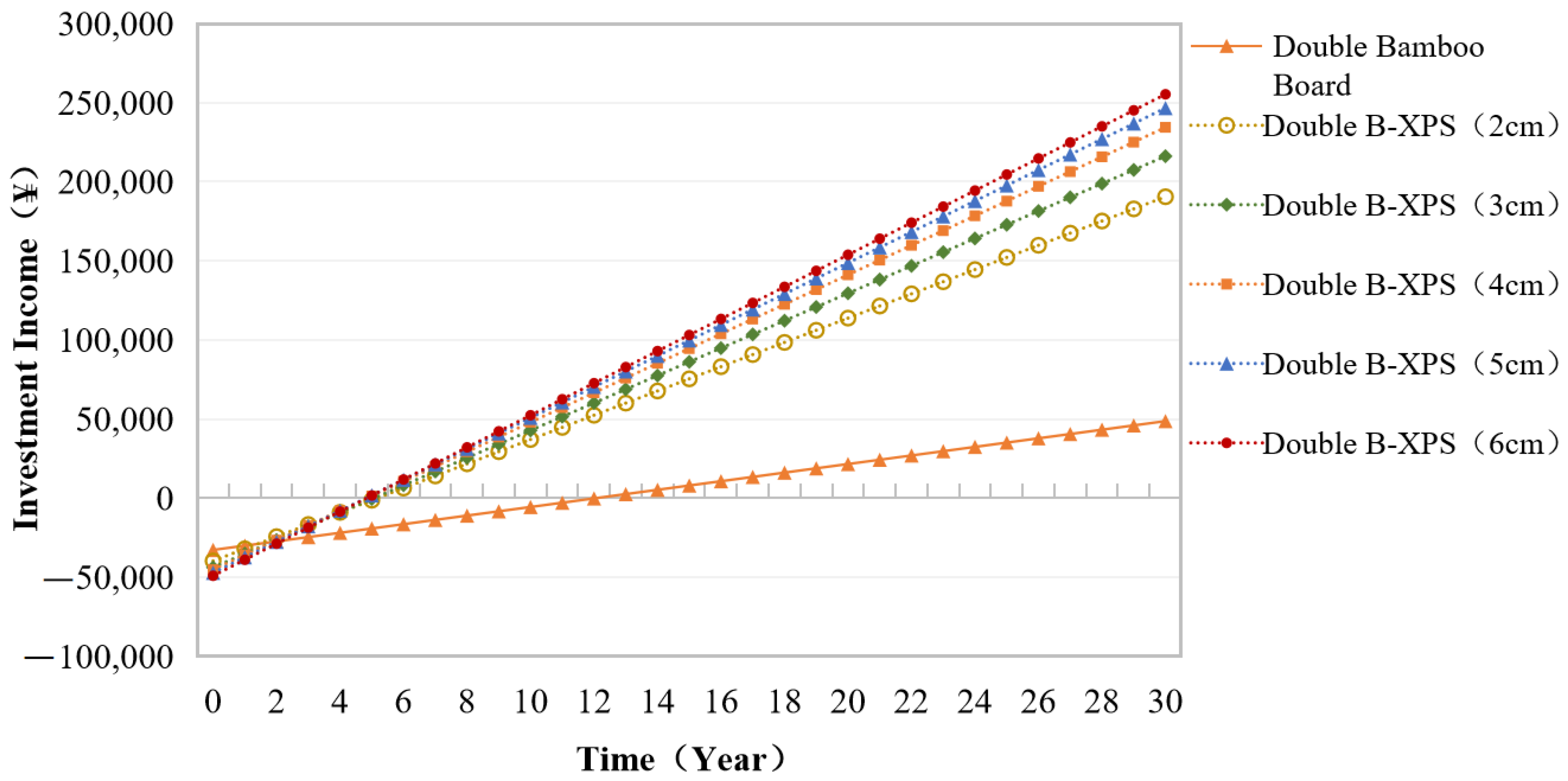
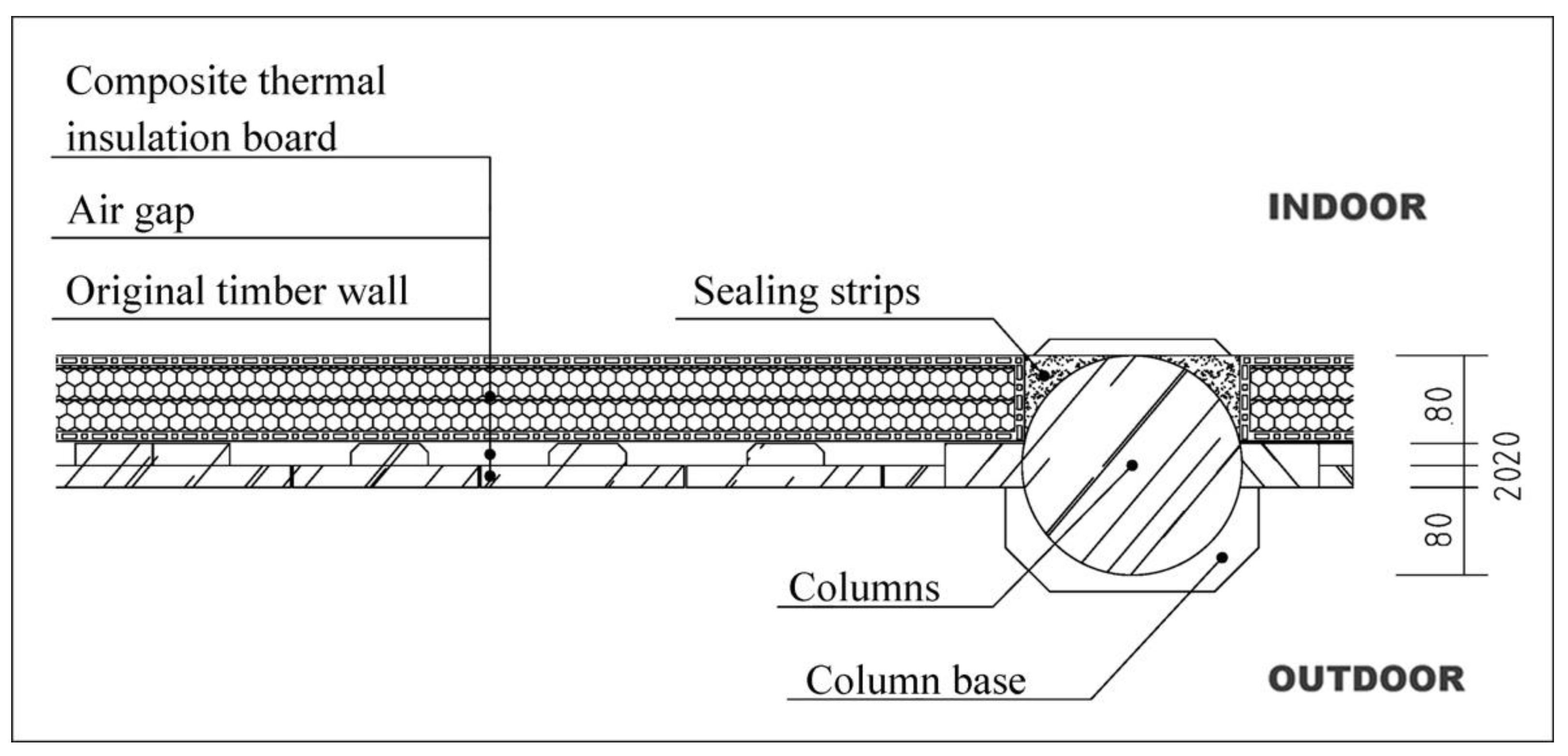
| Scope of Application | Advantage | Disadvantage | |
|---|---|---|---|
| Bamboo-wood composite fiberboard | Indoor wall materials | Good dampproof effect, convenient installation, and convenient size and pattern customization | Proneness to deformation under humid conditions, relatively fragile material texture, not high hardness, and easy scratching |
| XPS board | Widely applied to building thermal insulation design and transformation | High-cost performance, superior thermal insulation performance | Thermal resistance of thermal insulation material will be reduced under humid conditions [26] |
| Test Parameter | Testing Instrument | Measurement Accuracy |
|---|---|---|
| Indoor air temperature and humidity | Memory-type hygrometer TES-1361C | Humidity ±3%RH (25 °C, 20–80%RH) Temperature ±0.4 °C (+5–+60 °C) |
| Surface temperature of building envelope | IR thermometer FLUK F59 | ±2 °C |
| Air tightness | Blower door air tightness test system (Blower Door) | ±3% |
| Heat transfer coefficient | JTRG-I wall and glass thermal insulation performance detection device | Cooling/heating box control precision: ±0.2 °C |
| S/N | Village Name | Region | Quantity of Traditional Dwellings | Proportion of Wooden Structures | Proportion of Wooden Structures |
|---|---|---|---|---|---|
| 1 | Chuijia Tian Village | Lishui, Zhejiang | 16 | 75.3% | 4.2 |
| 2 | Yapan Village | Jinhua, Zhejiang | 25 | 95.8% | 4.1 |
| 3 | Boutou Village | Xianju, Zhejiang | 23 | 95.7% | 4.3 |
| 4 | Andian Village | Qingtian, Zhejiang | 24 | 100% | 3.8 |
| 5 | Xiapu Village | Tiantai, Zhejiang | 37 | 86.5% | 4.2 |
| 6 | Ha Shi Zhuang Village | Wencheng, Zhejiang | 13 | 46.2% | 4.1 |
| 7 | Yuxi Village | Shengzhou, Zhejiang | 8 | 100% | 3.7 |
| 8 | Baheyang | Shengzhou, Zhejiang | 12 | 75% | 3.8 |
| 9 | Shangwu Village | Shengzhou, Zhejiang | 16 | 100% | 4.1 |
| 10 | Lakeside Village | Suichang, Zhejiang | 21 | 76.1% | 4.4 |
| 11 | Cao Ling Village | Qingyuan, Zhejiang | 46 | 78.3% | 3.6 |
| 12 | Daji Village | Qingyuan, Zhejiang | 34 | 94.1% | 4.2 |
| 13 | Arrow Ridge Village | Fenghua, Zhejiang | 47 | 55.3% | 3.9 |
| 14 | Gaoqian Village | Xianju, Zhejiang | 52 | 98.1% | 4.3 |
| 15 | Hongtang Village | Dongyang, Zhejiang | 26 | 87.6% | 4.2 |
| 16 | Po Tong Village | Jinhua, Zhejiang | 11 | 89.6% | 4.6 |
| 17 | Pak Fuk Yan Village | Taishun, Zhejiang | 15 | 100% | 3.5 |
| 18 | Tuan Shi Village | Longyou, Zhejiang | 13 | 97.8% | 3.7 |
| Structure | Heat Transfer Coefficient W/(m2·K) | Heat Conductivity Coefficient W/(m·K) | Thickness/(mm) |
|---|---|---|---|
| Original wooden wall panel | 2.78 | 0.15 | 20 |
| Bamboo-wood composite fiberboard | 15.63 | 0.14 | 9 |
| XPS board | 1.73 | 0.03 | 20~60 |
| Retrofitted Part | Structure and Thickness (mm) | Heat Transfer Coefficient (W/m2⋅K) | Thermal Resistance R (m2⋅K/W) |
|---|---|---|---|
| Roof | Chinese-style tile (10 mm) + lime mortar (20 mm) + sheathing brick (18 mm) | 0.58 | 0.47 |
| Window | Wooden frame 20 mm | / | / |
| Exterior wall | Brick wall 240 mm Thin plank wall 20 mm | 2.04 1.11 | 0.04 0.62 |
| Foundation | Triple-combined soil (240 mm) | 3.62 | 0.03 |
| Floor slab | Plank (25 mm) | 0.74 | 0.62 |
| Working Condition Parameter | Value | |
|---|---|---|
| Indoor temperature setting | Summer | 26 °C |
| Winter | 18 °C | |
| Heating period | From December 12 to 28 February in the next year | |
| Cooling period | From 15 June to 31 August | |
| Air conditioning schedule | See Table 7 | |
| Meteorological data | Annual data of local typical climate | |
| Air tightness | 2.3 h−1 |
| Retrofitting Measure | Summer kWh/Mon. | Winter kWh/Mon. | Annual kWh/Year | Energy-Saving Rate |
|---|---|---|---|---|
| - | 2221 | 5460 | 30,377 | - |
| Double-layer bamboo-wood composite fiberboard | 1809 | 4537 | 25,033 | 17.6% |
| Double-layer bamboo-wood composite fiberboard + XPS board (2 cm) | 1056 | 2827 | 15,270 | 49.7% |
| Double-layer bamboo-wood composite fiberboard + XPS board (3 cm) | 907 | 2481 | 13,317 | 56.2% |
| Double-layer bamboo-wood composite fiberboard + XPS board (4 cm) | 807 | 2250 | 12,027 | 60.4% |
| Double-layer bamboo-wood composite fiberboard + XPS board (5 cm) | 735 | 2085 | 11,099 | 63.5% |
| Double-layer bamboo-wood composite fiberboard + XPS board (6 cm) | 679 | 1963 | 10,404 | 65.8% |
| Simulated Energy Consumption (kWh) | Actual Electricity Consumption (kWh) | Error Rate | |
|---|---|---|---|
| Annual | 5062.8 | 4734.2 | 6.94% |
| Each month in summer | 370.1 | 358.4 | 3.26% |
| Each month in winter | 910.0 | 751.9 | 21.03% |
| Retrofitting Measure | Material Cost ¥/m2 | Total Cost ¥ | Cost of Unit ¥/m2 |
|---|---|---|---|
| Double-layer bamboo-wood composite fiberboard | 68.8 | 32,758.8 | 82.6 |
| Double-layer bamboo-wood composite fiberboard + XPS board (2 cm) | 83.4 | 39,710.5 | 100.1 |
| Double-layer bamboo-wood composite fiberboard + XPS board (3 cm) | 92.1 | 43,853.1 | 110.5 |
| Double-layer bamboo-wood composite fiberboard + XPS board (4 cm) | 95.1 | 45,281.4 | 114.1 |
| Double-layer bamboo-wood composite fiberboard + XPS board (5 cm) | 99.1 | 47,186.1 | 118.9 |
| Double-layer bamboo-wood composite fiberboard + XPS board (6 cm) | 103.1 | 49,090.6 | 123.7 |
| Retrofitting Measure | Energy Efficiency | Cost of Unit Area (¥/m2) | Investment Payback Year |
|---|---|---|---|
| Double-layer bamboo-wood composite fiberboard | 17.6% | 82 | 13.07 |
| Double-layer bamboo-wood composite fiberboard + XPS board (2 cm) | 49.7% | 100 | 6.17 |
| Double-layer bamboo-wood composite fiberboard + XPS board (3 cm) | 56.2% | 110 | 6.06 |
| Double-layer bamboo-wood composite fiberboard + XPS board (4 cm) | 60.4% | 114 | 5.86 |
| Double-layer bamboo-wood composite fiberboard + XPS board (5 cm) | 63.5% | 118 | 5.82 |
| Double-layer bamboo-wood composite fiberboard + XPS board (6 cm) | 65.8% | 123 | 5.84 |
Publisher’s Note: MDPI stays neutral with regard to jurisdictional claims in published maps and institutional affiliations. |
© 2022 by the authors. Licensee MDPI, Basel, Switzerland. This article is an open access article distributed under the terms and conditions of the Creative Commons Attribution (CC BY) license (https://creativecommons.org/licenses/by/4.0/).
Share and Cite
Rao, X.; Qi, F.; Zhang, X.; Mao, Z. Evaluation Method on Energy-Efficient Retrofitting of Wooden Walls of Chinese Traditional Dwelling—A Case Study of Rendetang in Jinhua. Buildings 2022, 12, 1017. https://doi.org/10.3390/buildings12071017
Rao X, Qi F, Zhang X, Mao Z. Evaluation Method on Energy-Efficient Retrofitting of Wooden Walls of Chinese Traditional Dwelling—A Case Study of Rendetang in Jinhua. Buildings. 2022; 12(7):1017. https://doi.org/10.3390/buildings12071017
Chicago/Turabian StyleRao, Xiaoxiao, Feng Qi, Xiaoxiao Zhang, and Zhuoxun Mao. 2022. "Evaluation Method on Energy-Efficient Retrofitting of Wooden Walls of Chinese Traditional Dwelling—A Case Study of Rendetang in Jinhua" Buildings 12, no. 7: 1017. https://doi.org/10.3390/buildings12071017
APA StyleRao, X., Qi, F., Zhang, X., & Mao, Z. (2022). Evaluation Method on Energy-Efficient Retrofitting of Wooden Walls of Chinese Traditional Dwelling—A Case Study of Rendetang in Jinhua. Buildings, 12(7), 1017. https://doi.org/10.3390/buildings12071017





